FundamentalsThe block diagram of a direct conversion radio is given in figure 1. The local oscillator is at the center of the desired passband and frequencies close to it will show up as audio frequency signals in the mixer outputs. An ideal mixer produces the sum and the difference frequency only while a real mixer also responds to overtones of the local oscillator.The first box, the filter, is inserted to supress receiver response at the overtones of the local oscillator, 288 and 432MHz for the 144MHz receiver described in detail on this page. The relative phase between LO and RF must differ by about 90 degrees between the I and Q channels. Modest errors in the phase can be compensated by the computer but the relative phases and amplitudes must be very stable. The 90 degree phase shifter can be just a 1/4 wavelength section of coaxial cable. The mixers shift the frequency from around 144MHz to audio frequencies. If standard devices with schottky diodes are used, as in the design presented here, the signal is also attenuated by about 8dB. The audio amplifiers amplify the very low voltage present at the mixer output to a level that fits the soundcard of the computer. |

Soundcard noise levels.The audio boards have high input impedance. The Delta44 input impedance is 10 kiloohms for example. Fundamental physics will teach us that any room temperature resistor will deliver -174 dBm per Hz of bandwidth to another resistor with the same resistance. If that other resistor is held near absolute zero the net power transfer would be -174 dBm. It is the equivalent of black-body radiation and holds up to frequencies where quantum mechanical effects come into play.When a zero Kelvin resistor is in parallel with a room temperature resistor the voltage across the cold resistor U = sqrt(P*R) where P is -174 dBm. A 10 kiloohm room temp resistor would thus generate sqrt(10000 * 10-0.1*(174+30)) volts across another 10 k resistor if this other resistor were held at absolute zero. That is for 1 Hz of bandwidth and evaluates to 6.3 nV. (1 dBm is 30 dB below 1 W. That is the origin of 30.) The noise level of the Delta44 in its original shape is about 145 dB below saturation in 1 Hz bandwidth in the least sensitive setting, (ossmix +4DB.) Saturation is at about 3.5 V RMS (10 V p-p) which means that the noise floor is at about 200 nanovolts. If the Delta44 were noise free it would act as a 10 K resistor held at zero degrees kelvin so the noise floor is 30 dB higher than it would have been if the Delta44 were ideal. The noise figure is thus 30 dB. In the most sensitive position (ossmix -10DB) the noise figure is about 20 dB. These noise figures are the noise figures for a 10 kiloohm source impedance to which the Delta 44 would be power matched. (There have been errors on this page with too low noise figures given for the Delta 44. Thanks to Clemens, DL4RAJ those errors were corrected Jan 2010) The disadvantage of setting the soundcard in high sensitivity mode is that the the noise floor becomes higher in relation to the limit where the A/D converter saturates. The signal level corresponding to the noise floor is lowered by about 10 dB but the signal level corresponding to A/D saturation is lowered by about 14 dB!! The low noise amplifier one can select to use does not only have a low noise figure, it also contributes some noise. Adding a preamplifier to get better noise figure will normally result in reduced dynamic range. Now, for use as the amplifier following a schottky diode mixer, the soundcard preamplifier is a bad choice. When used directly on a 50 ohm source the SWR is very high. One can compute the NF by adding the mismqatch loss 17 dB and find 50 ohm noise figures of 37 and 47 dB respectively. A good low noise amplifier will have a noise voltage of about 1 nV in 1 Hz bandwidth and it could be arranged for a much higher input impedance than 50 ohms. It would then have a NF in the order of 2 dB. By connecting such an amplifier in front of the Delta 44 in lowest gain mode and setting the gain for the noise floor to rise by 3 dB one would get a noise figure in the order of 5 dB and still have 1 dB more dynamic range than the Delta 44 in its most sensitive mode. Even though it is possible to connect the A/D board directly to schottky mixers Very low cost radio, it is obvious that a low noise amplifier designed for minimum noise at about 50 ohm input impedance will allow lower signal levels out from the mixer with better performance for strong signals as a result. Low noise, low impedance audio amplifiersThe easiest way to get a low noise amplifier suitable for use between the schottky mixers and the computer audio boards is to use the AD797 from ANALOG DEVICES. This amplifier is designed for use as low noise amplifier The noise figure is close to zero at 200 ohms input impedance and well below 2dB at 50 ohms. This amplifier is specified to have total harmonic distorsion below -120dB so it will not degrade performance for large signals. The A/D boards have their harmonic distorsion in the -90 to -100dB range. Linearity of A/D boardsThe problem with the AD797 is cost and avaliability. The two channel direct conversion radio described here would need four of these amplifiers at a total cost of USD 45 (April 2001). It is possible to get equally good performance using low cost standard components as shown in fig. 2. |

|
The amplifier in fig.2 is not difficult or critical in any way.
The basic idea is to add a low level preamplifier with a
bipolar transistor having high current in front of a low cost
low noise op-amp.
Note that it is essential to use a filter to prevent RF or LO
to reach the transistor. See below.
The second stage gives a voltage gain of 3.51 which is about as much gain one can use from a RC4136 without any noise at the output detectable with a Delta44 board in high level mode (ossmix +4DB) The second stage is just an ordinary inverting amplifier but the input resistor is split in two halves to get a point where a LC notch filter can be added. This notch filter gives very high attenuation at 52kHz while it does not affect frequencies below 48 kHz at all. The optional notch filter extends the useful frequency range from about 89 to 92 kHz and is by no means necessary. The B+ voltage, half the supply voltage, is common to all 4 channels, I and Q for two antennas. The first stage, consisting of a bipolar transistor and a RC4136 section has a voltage gain of 1036/36 = 28.8 times. The A+ voltage is common to all 4 amplifiers. The component values in the schematic diagram are for a supply voltage in the range 12 to 20 volts to give a voltage at the collector of 2 to 3 volts. The A+ voltage and the collector resistor, 3.3k ohms in the schematic diagram set voltage and current of the input transistor and can be optimised for lowest noise figure. The 300 kiloohm resistor that feeds the output DC voltage back to the base of the transistor has to be selected to make the output DC voltage exactly half the supply voltage. (Change if A+ or collector resistor is changed) More clever ways of making the DC feedback are possible to avoid the need for adjustment, but this one is simple. Resistor values range from 270 to 330 kiloohms in my 4 amplifiers. By feedback on the emitter the input impedance of this amplifier is high. If the input is left open it produces an increased noise level. This amplifier is designed to have a schottky diode mixer connected to IN so the base will see a low impedance and then the transistor will produce very little noise. The transistor can be anyone of BC489A, BFX34 or BUY49S. Typical low noise audio transistors like BC109 or BCY59 give much more noise. They are designed for smaller currents and give good noise performance at higher impedances. Probably any transistor rated about 1A with a transition frequency above 120MHz will work well. The compensation capacitors, 47pF, should not be made larger than required to get stable operation. With the component values of fig.1 the amplifier matches the Delta44 A/D board and does not degrade the harmonic distorsion of the system. The second harmonic is below -100dB at full output level and higher orders are well below. The audio amplifier presented here increases the noise floor of the Delta44 audio board by 1dB. Trading 1dB of headroom between noise floor and saturation for a 40dB lower signal level out from the mixers is a reasonable compromise. Selecting mixer type for highest spur free dynamic rangeA low level mixer such as SBL-1 or TUF-1 saturates at an input level of 1dBm or 0.71 volts P-P. In a 50 ohm load the output level is 9dB lower, 8dB attenuation and 1dB compression, or 0.25 volts P-P.A high level mixer such as RAY-1 saturates 14dB higher and needs 14dB more LO power. It is obvious that the low level mixers will produce harmonic distorsion and intermodulation when they deliver the 100 millivolts P-P required to saturate the Delta44 board since this level is only 8dB below the 1dB compression point. For this reason it would be natural to select a high level mixer. Using a RAY-1 gives good intermodulation and harmonic properties for the mixer, compatible with the performance of the Delta44 itself. The mixer does not only mix the LO with the RF signal. It also mixes the LO carrier with the noise sidebands that surround the carrier. Using a RAY-1 without severely degrading the noise floor, particularly at low frequencies is not compatible with normal local oscillators. The IC202 produces a relatively clean signal, but it is far from good enough to use as local oscillator together with a RAY-1 mixer. The degradation caused by the noise sidebands of the IC202 is as follows: Frequency Degradation 40kHz 6dB 10kHz 10dB 4kHz 20dB 1kHz 30dB To use this configuration, a IC202 for LO and a RAY-1 mixer one has to add 30dB of RF gain to overcome the noise 1kHz away from the band center. To not loose dynamic range in the Delta44 it is then necessary to reduce the audio amplifier gain by 30dB Then the RAY-1 will be saturated before the Delta44. For use with high level mixers in a direct conversion receiver a much better LO than the IC202 is required. By using a low level mixer with 14dB lower LO power one reduces the low frequency noise from the oscillator mixing with the LO sidebands by 28dB which means that the IC202 is good enough to use as local oscillator. The harmonic distorsion from the mixer is the dominating non-linearity, a signal that nearly saturates the Delta44 produces overtones that are about 60dB below the fundamental if the mixer is NOT loaded by 50 ohms. The filter of fig. 2 followed by the amplifier of fig.1 does not load the mixer, which means that the output voltage is twice as high compared to a 50 ohm load. Leaving the mixer unloaded means that the input signal can be reduced by 6dB for the same output voltage, but saturation of the output is at 330 millivolts giving a better margin between saturation and the level giving full signal for the Delta44. In all texts I have seen about the use of schottky diode mixers it is stated that the mixer must be terminated in 50 ohms. When the IF frequency is low, 0 to 45kHz this is not true. The same is very probably the case for normal IF frequencies like 10.7MHz if the combined performance of the mixer and the amplifier following it is considered. Allowing the IF amplifier to be loaded by the output impedance of the mixer only reduces the noise floor because the noise level of the amplifier will increase much less than 6dB when the 50 ohm termination is removed. When comparing the intermodulation properties for signals at a certain level above the noise floor the unloaded mixer gives better performance than the loaded one. In case the IF amplifier uses noise free feed back to present the mixer with a 50 ohm load the situation may be different. That is feasible at normal IF frequencies but not in a direct conversion radio. Filters must protect the audio amplifier from RF signalsThe peak to peak voltage at the output of the mixer is 100 millivolts for the strongest permissable in band signal. The output amplitude is then about 10 volts peak to peak which is about the level required to saturate the Delta44 board. The mixer is wideband and will of course produce the same level independently of the frequency separation between the local oscillator and the RF signal. The audio amplifier can not deliver the 10 volts P-P output at high frequencies. Already at 75kHz the second stage of the amplifier in fig.2 limits the amplitude because of inadequate slew rate of the RC4136. In this respect the AD797 is much better, it goes up to about 300kHz.The first amplifier stage of the amplifier in figure 2 works all the way up to 150kHz because it is not required to deliver as high output voltage. The compensation capacitors slow it down but the three times lower output amplitude eases the slew rate requirements. The small signal bandwidth of the first amplifier stage of fig. 2 is 2MHz. At this frequency the first stage can only deliver about 100 millivolts P-P corresponding to only 3.5 millivolts at the input. It is absolutely necessary to protect signals 1 to 2MHz away from the center frequency from reaching the audio amplifier to prevent strong intermodulation between signals that are only a few millivolts at the mixer output. In the 144MHz receiver described here the center frequency is fixed near 144.100MHz. If no filters are used severe problems would arise from strong FM signals in the 145 to 146MHz range that would mix with each other in the first audio amplifier stage which is non-linear already 30dB below the stronges permissible in band signal. A filter directly on 144MHz can not provide the desired attenuation so a filter must be inserted between the mixer and the audio amplifier. The filter must attenuate by at least 30dB at 1MHz to give a similar dynamic range for signals in the 145 to 146 MHz region as for the desired 90kHz passband around about 144.100MHz. The mixer is capable of giving more output than 100 millivolts, it is a good idea to suppress signals around 1MHz by more than 40dB for a low level mixer like SBL-1 or TUF-1 while 60dB attenuation is useful if a high level mixer is used. The filter shown in fig. 3 has the following characteristics: Freq Attenuation 79kHz 20dB 115kHz 30dB 173kHz 40dB 263kHz 50dB 395kHz 60dB 567kHz 70dB 764kHz 80dB The impdance level is chosen to not load the mixer. The filter degrades the noise figure slightly at frequencies above 30kHz because the input transistor of the audio amplifier will see a much higher impedance than 50 ohms there. There is one important complication with this filter. The inductors may pick up magnetic fields at the mains frequency. |

Local oscillator for direct conversion 144MHz receiverTo get a good idea about the absolute levels of sideband noise of different local oscillators at 144MHz two X-tal oscillators as shown in fig. 4 were built. One is used used as the local oscillator in the 144MHz direct conversion radio while the other was used as a test signal. Fig. 5 shows the spectrum at 10Hz resolution bandwidth when the 144 MHz X-tal oscillator is the signal source. Fig. 6 shows the noise floor, everything the same as fig.5 except that the test signal is switched off. |
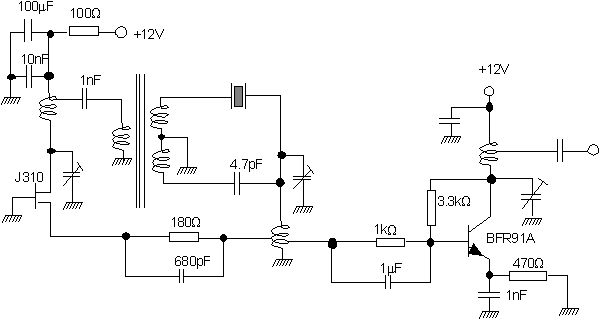
|
To adjust the X-tal oscillator, break up the feed back loop
by connecting the 180 ohm source resistor to ground and feed
a signal source to the 680pF source capacitor.
This way the oscillator is converted to a X-tal filter for 144MHz.
Tune capacitors for max signal and move the tap at the drain coil
for maximum signal.
place a 50 ohm load at the point where the feed back will be
taken from and adjust the tap for maximum gain.
The gain has to be a little more than one for the amplifier to
oscillate through the filter when the feed back is in place.
The 16MHz X-tals have many resonances but the strongest one
is usually about 10 dB stronger than the second strongest.
Some X-tals have a very small difference between the two strongest
resonances and should be avoided.
|
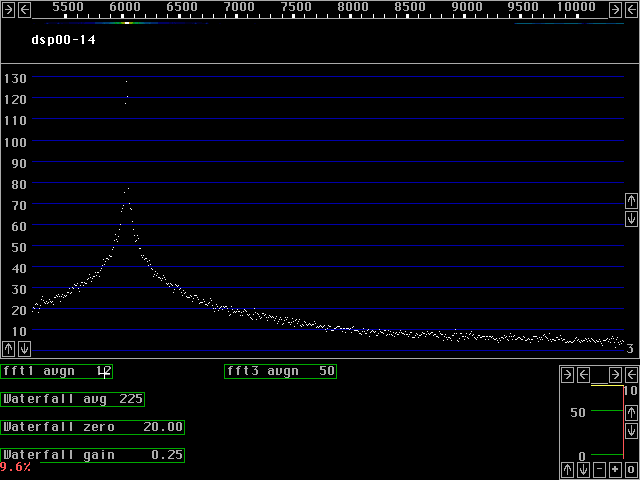
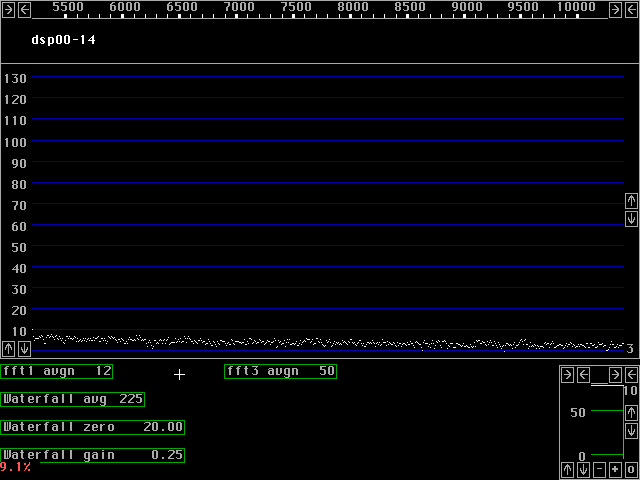
From fig.5 the sideband noise levels of a single X-tal oscillator
can be estimated to the following values assuming the two
oscillators are similar:
Separation Noise level in 1Hz bandwidth
(kHz) below carrier (dB)
1 123
2 133
4 140
At 4kHz offset the noise floor is lifted by about 2dB which means
that the combined noise from both the LO and the RF signal and from
the flat noise floor itself is 1.6 times above the flat noise floor
which means that the sideband noise from the LO is 0.3 times the flat
noise floor or at about -3dB, 130dB below the carrier or 140dB in
1Hz bandwidth.
This estimation is not very accurate.
This result is discouraging compared to a state of the art 100MHz X-tal oscillator which is 40dB better according to fig.8 in the article Beyond Fractional-N, published in QEX Mar/Apr 2001 page 24. The X-tal oscillator described here is the best 144MHz signal source I have ever seen. With one of them as the local oscillator the direct conversion radio is well suited to check the performance of conventional ham radio transmitters. Fig. 7 shows the spectrum of the IC202 with the same settings as those used to record figures 5 and 6. The IC 202 measurement shows similar results close to the carrier but at a frequency separation of 4kHz the IC 202 has reached its flat noise floor which is at -133db in 1Hz or -100dB in SSB bandwidth. The direct conversion receiver described here is more or less compatible with good quality 144MHz transceivers. Dynamic range of 2 m Transceivers |

Final discussionThe radio described here has reasonable properties for large signals. The dominating non-linearity is the SBL-1 which is operated about 17 dB below its saturation level for the maximum signal permitted by the Delta44.The noise figure is about 20dB and the Delta44 saturates at -14dBm. Fig. 8 shows the full spectrum of the IC202 when the level is close to saturation and fig. 9 shows the corresponding noise floor. Undesired signals caused by the SBL-1 non-linearities are about 60dB below the carrier corresponding to an intercept point IP3 somewhere around +10dBm. |
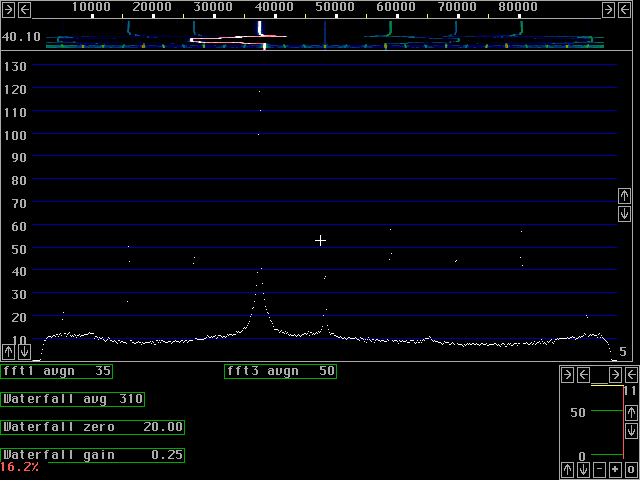
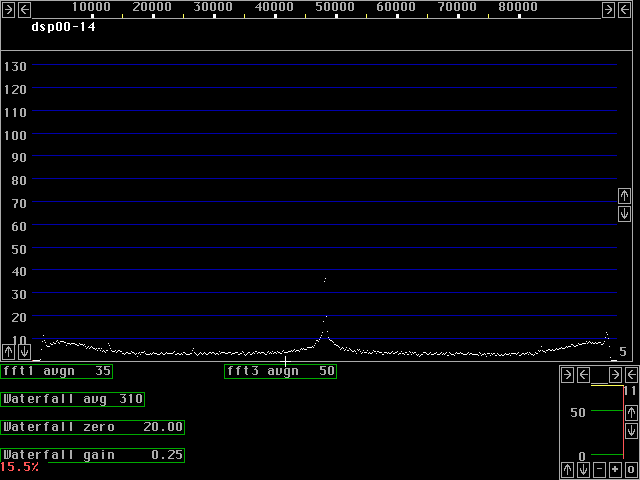
|
To use the direct conversion receiver described here in a ultra low
noise system one has to add about 35dB RF gain.
20dB to overcome the noise figure and another 15 dB to make
the noise from the preamplifier dominate over the rest of the
system noise by about 17dB.
The IP3 at the antenna will then be about -25dBm.
To test the direct conversion radio with respect to interference from signals at large frequency separations a AM modulated signal was used. When the level is adjusted to nearly saturate the Delta44 the SBL-1 produces audio of the modulation frequency at a level about 75dB below the carrier. The SBL-1 works as a AM detector, sending signals into the RF port gives detected AM at the IF port. The AM detection is wideband, the level does not change even if the frequency is changed by 10MHz in either direction. The non-linearity responsible for AM detection will of course mix all signals with each other and a good band pass filter in the RF amplifier chain will eliminate problems from strong out of band signals. This direct conversion receiver is low cost. The total component count for a complete two channel system and approximate component cost is as follows: Item no total SEK LO: trimmers 3 25 J310 1 3 Bipolar 1 3 X-tal 2 20 (every second perhaps useless ??) R and C 14 14 MIXER: TUF-1 4 140 FILTER: inductors 12 30 R and C 20 20 AMPLIFIER RC4136 2 12 bipolars 4 8 R and C 56 50 Sum 325The components add up somewhere around $30. The notch filters are excluded, I do not know what they would cost. The unit is uncritical and easy to build except for the X-tal oscillator that well can be replaced by something more conventional like a 12MHz X-tal running at 36MHz followed by two frequency doublers. It is interesting to have investigated the direct conversion radio built around standard schottky diode mixers. Comparing the experiences to the experiences with CMOS mixers makes it quite clear that the way to go is to make a two step conversion. The CMOS mixers can operate from a low noise X-tal oscillator at a fixed frequency in the 2.5 to 20MHz range. Filters with a bandwidth of about 100kHz can be used to protect these mixers from strong out of band signals. To mix from 144 to the fixed frequency a conventional design with high level schottky mixers can be used without the problems of LO sidebands mixing with the LO carrier since then the IF if far above the audio range. |